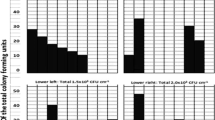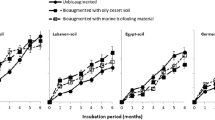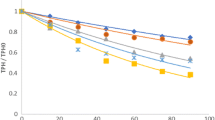Summary
Using a model system containing 10% soil and a 1.35% hydrocarbon mixture of tetradecane, pentadecane, hexadecene, pristane (2,6,10,14-tetramethylpentadecane), trimethylcyclohexane, phenyldecane and naphthalene suspended in a mineral salts medium, the hydrocarbon degradation rate by a soil population was 25.7 g model oil per kg soil dry weight per day under non-limited conditions within two degradation phases. During the first degradation phase only the most water-soluble naphthalene was degraded, while the other components could only be metabolized when the interfacial tension was lowered by the production of surfactants at the beginning of the second degradation phase. This second degradation phase ended when 89% of the hydrocarbons were metabolized.
Similar content being viewed by others
References
Asselineau C, Asselineau J (1987) Trehalose-containing glycolipids. Progress in the chemistry of fats and other lipids 16:59–99
Bossert I, Bartha R (1984) The fate of petroleum in soil ecosystems. In: Atlas RM (ed) Petroleum microbiology, Macmillan, New York, pp 355–397
Bradford MM (1976) A rapid and sensitive method for the quantitation of microgram quantities of protein utilizing the principle of protein-dye-binding. Anal Biochem 72:248–254
Brandes B, Wagner F (1987) Einfluß von Biotensiden auf den mikrobiellen Abbau von Naphthalin. Dechema Jahrestagung der Biotechnologen Frankfurt 1987, p 211
Brown DE (1970) Aeration in the submerged culture of microorganisms. In: Norris JA, Ribbons DW (eds) Messages in microbiology, 2nd edn. Academic press, New York, pp 125–174
Brown RA, Huffman HL (1976) Hydrocarbons in open ocean waters. Science 191:847–849
Dibble JT, Bartha R (1979) Effect of environmental parameters on the degradation of oil sludge. Appl Environ Microbiol 37:729–739
Ewald M (1986) Verfahren zur Bestimmung der Toxizität von Abwasser und Abwasserinhaltsstoffen nach der Dehydrogenase Aktivität mittels Resazurin. Dechema Jahrestagung der Biotechnologen, Frankfurt 1986, pp 149–150
Fawcett JK, Scott JE (1960) A rapid and precise method for the determination of urea. J Clin Path 13:156–159
Huddleston RL, Cresswell LW (1975) Environmental and nutritional constraints of microbial hydrocarbon utilization in the soil. In: Proceedings of 1975 engineering Foundation Conference: The Role of Microorganisms in the Recovery of Oil. NSF/RANN, Washington, pp 71–72
Krebs KG, Heusser D, Wimmer H (1967) Sprühreagenzien. In: Stahl E (ed) Dünnschichtchromatographie. Springer, Berlin, Heidelberg, New York, pp 813–859
Liu D, Strachan WMJ (1979) Characterization of microbial activity in sediment by resazurin reduction. Arch Hydrobiol 12:24–31
Pelz B, Rehm HJ (1972) Isolierung, Substratassimilation und einige Produkte alkanabbauender Schimmelpilze. Arch Microbiol 84:20–28
Perry JJ, Scheld HW (1968) Oxidation of hydrocarbons by micoorganisms isolated from soil. Can J Microbiol 14:403–407
Rambeloavisoa RJF, Giusti G, Duvnjak Z, Bertrand JC (1984) Degradation of crude oils by a mixed population of bacteria isolated from sea-surface foams. Mar Biol (Berlin) 83:69–81
Rapp P, Bock H, Wray V, Wagner F (1979) Formation, Isolation and characterization of trehalose dimycolates from Rhodococcus erythropolis grown on n-alkanes. J Gen Microbiol 115:491–503
Rehm HJ, Reiff I (1981) Mechanisms and occurrence of microbial oxidation of long-chain alkanes. Adv Biochem Eng 19:175–215
Ristau E, Wagner F (1983) Formation of novel anionic trehalosetetraesters from Rhodococcus erythropolis under growth limiting conditions. Biotechnol Lett 5:95–100
Walker JD, Colwell RR (1974) Microbial petroleum degradation: use of mixed hydrocarbon substrates. Appl Microbiol 27:1053–1060
Author information
Authors and Affiliations
Additional information
Dedicated to Professor F. Wagner on the occasion of his 60th birthday
Rights and permissions
About this article
Cite this article
Oberbremer, A., Müller-Hurtig, R. Aerobic stepwise hydrocarbon degradation and formation of biosurfactants by an original soil population in a stirred reactor. Appl Microbiol Biotechnol 31, 582–586 (1989). https://doi.org/10.1007/BF00270799
Received:
Accepted:
Issue Date:
DOI: https://doi.org/10.1007/BF00270799




